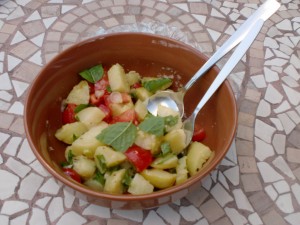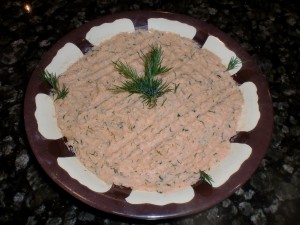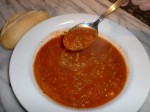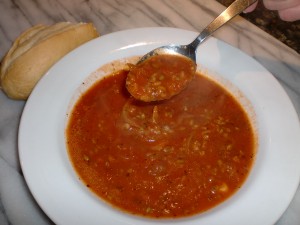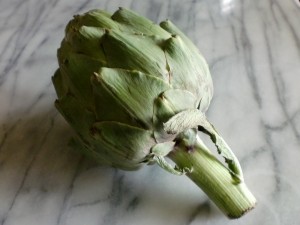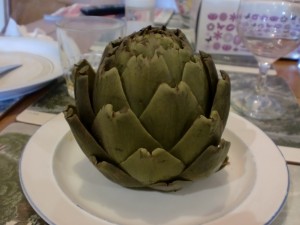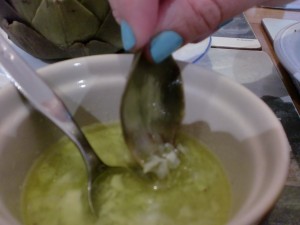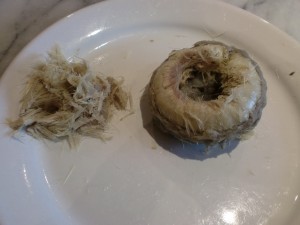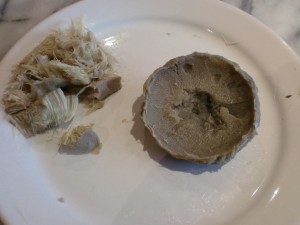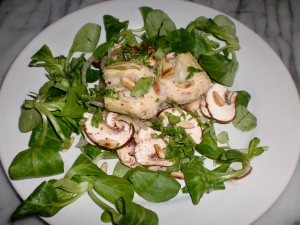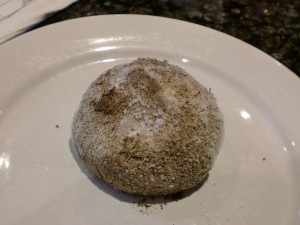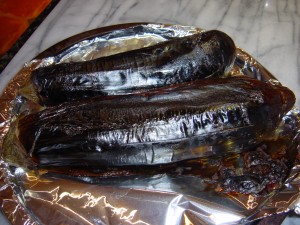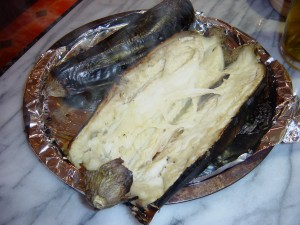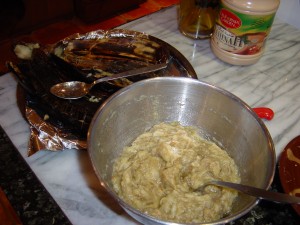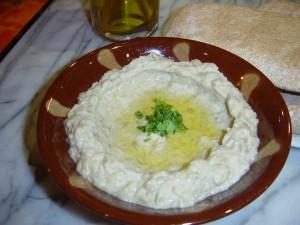With Christmas coming, I thought of the Lebanese savoury pastries as a versatile option. Although they are part of the mezza, they can also be served as canapés because you can make them any size you like and vary the filling. It might sound fiddly and long-winded, but in fact, the pastry is very simple to make, as for the filling, it cannot be easier. Another great advantage is that you can prepare them ahead of time and freeze them until needed.
Traditionally, the fillings are made with cheese, meat, spinach and Swiss chard or herbs. When the filling consists of meat or cheese, the pastry is made into a crescent shape and called Sambusik which could be Sambusik b’Jibneh/ Cheese Crescent or Sambusik b’Lahmeh/ Meat Crescent. As for the pastries with spinach filling or other greens they are called Fatayer like Fatayer b’Sbanegh/ Spinach Triangles which are the most popular or Fatayer b’Sili’ / Swiss chard Triangles.
Ajeenet al-Fatayer wa al-Sambousik
Traditional Savoury Pastry
Ingredients.
· 225g / 8 oz self raising flour
· ¼ tsp salt
· 2 tbsp vegetable or olive oil
· enough tepid water to make soft dough about 100-120ml / 3½ fl oz- 4 fl oz
Method.
- In a large bowl, sift the flour and salt, then make a well in the centre. Using the tip of your fingers, rub in the oil. Add the water gradually, while kneading with your hands to form a soft elastic dough. Alternatively, you can make it in the food processor using the dough hook.
- Cover with a cloth and let it rest for half an hour at room temperature, then the dough is ready for use.
Sambousik b’Lahmeh (Minced Meat Crescents)
Sambousik are usually deep fried, however, I have tried them baked which works well but, it did not give them that fluffiness that deep frying does. Another bonus with sambousik is that they freeze well but you have to cook them first, and when you need to serve, defrost thoroughly, then simply heat in the oven (fan 180°C / 200°F). The amount of filling required here is sufficient for 1 quantity of Traditional Savoury Pastry. However, if you want to split the dough to try different fillings, then reduce the amount accordingly.
Makes about 23 pieces (using a cutter 8½ cm/ 3½ inches diameter)
Ingredients.
· 1 quantity of Traditional Savoury dough (see recipe)
For the filling
· 10 ml vegetable oil
· 25 g/1 oz pine nuts
· 1 medium onion finely chopped
· 120 g/ 4½ oz minced lamb
· Seasoning: salt to taste, 1 tsp ground allspice, ½ tsp ground black pepper, ¼ tsp cinnamon
· 1 tbsp lemon juice or pomegranate syrup
Method.
- Heat up the oil in a medium-sized frying pan using medium heat. Add the onions and cook for 1 minute after which you add the meat. Fry breaking up any lumps with the spoon and cook until the meat is browned.
- Meanwhile, wipe with a little bit of oil another small frying pan. Using low to medium heat setting, sauté the pine nuts until golden brown, here, you have to be very watchful because pine nuts can burn easily.
- Once the meat is ready, season, stir in the pine nuts and then add the juice. Give the whole thing a good stir. Let it cool, so it is easy to handle.
- Sprinkle the working surface with a little flour and keep some flour handy for you will need it during the process. You will also need a table knife. I find the easiest way is to divide the dough into 3 balls and work with each one in turn. Keep the pastry you are not using covered with a cloth or cling film to prevent it from drying out. Take the first ball and with a rolling pin, roll it out into a circle of about 3 mm/ 1/8 inch thickness. Cut into circles of 8½ cm/ 3½ inches diameter which I think is suitable for canapés and for a beginner. If you are more adventurous you can cut them to 7cm/ 3inches. Gather together pastry cuttings, dust with some flour, knead them together, re-roll and cut into other circles until the first batch is finished.
- Once you have cut the first batch, place 2 tsp of filling on each circle for medium sized or less depending on the size.
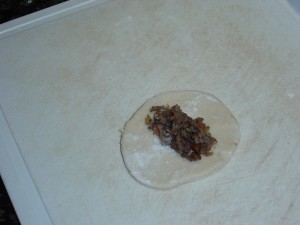
The meat filling
Now fold over the circle into a crescent shape, pinch the edges together and fold twisting so you end up with a pleated firm edge.
Put each sambousik on a plate sprinkled with a little flour.
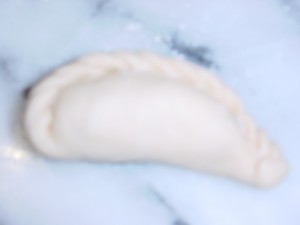
The finished pleated seam
You can deep fry in hot oil but if you want to finish all batches, it is advised to cover the prepared sambousik with lightly oiled cling film.
- To deep fry them, heat up the oil in a deep pan, you need enough vegetable oil to generously cover the sambousik, give them enough room to float around and most probably you need to fry them in batches. When the temperature reaches 180°C/ 350°F (enough for a small cube of bread to crisp in 1 minute), place gently sambousik and fry turning once until they are golden. Remove with a slotted spoon and drain excess oil by placing them onto kitchen paper.
- If you want to try them baked. Pre-heat a fan oven to 200°C / 400°F place sambousik on a generously greased baking sheet, brush the top with vegetable oil and bake for 10-12minutes until golden then turn them over and bake for another 10 minutes.
- Serve hot or warm with wedges of lemon.
Sambousik b’ Jibneh (Cheese Crescents)
You can use any cheese you like, on its own or flavour it with other ingredients if you wish. My family’s favourite is Halloumi which melts beautifully inside the pastry without becoming runny or leaking. Sambousik are usually deep fried, however, you could try them baked. Once cooked, Sambousik freeze well, but you need to defrost them thoroughly then simply reheat in a pre-heated oven 180°C / 350°F for about 5 to 7 minutes.
Makes about 23 pieces (using a cutter 8½ cm/ 3½ inches diameter)
Ingredients.
· 1 quantity of Traditional Savoury Pastry
For the filling.
· About 200 g / 7 oz of Halloumi cheese finely chopped or grated
· enough vegetable oil to deep fry
Method
1. Sprinkle the working surface with a little flour and keep some flour handy for you will need it during the process. You will also need a table knife. I find the easiest way is to divide the dough into 3 balls and work with each one in turn. Keep the pastry you are not using covered with a cloth or cling film to prevent it from drying out. Take the first ball and with a rolling pin, roll it out into a circle of about 3mm / 1/8 inch thickness. Cut into circles of 8½ cm / 3½ inches diameter which I think is suitable for canapés and for a beginner. If you are more adventurous you can cut them to 7cm/ 3inches. Gather together pastry cuttings, dust with some flour, knead them together, re-roll and cut into other circles until the first batch is finished.
2. Once you have cut the first batch, place one circle on a flat surface and put enough filling roughly one full teaspoon and spread it along the middle, leaving the edges untouched. Now fold over the circle into a crescent shape, pinching tightly the edges to seal, once done, twist over the edges so you end up with a firm pleated edge. Put each sambousik on a plate sprinkled with a little flour. You can deep fry in hot oil but it is better to finish all batches. It is advisable to cover the prepared sambousik with lightly oiled cling film until you are ready to cook.
3. To deep fry them, heat up the oil in a deep pan, you need enough vegetable oil to generously cover the sambousik, give them enough room to float around and most probably you need to fry them in batches. When the temperature reaches 180°C/ 350°F (enough for a small cube of bread to crisp in 1 minute), place gently sambousik and fry turning once until they are golden. Remove with a slotted spoon and drain excess oil by placing them onto kitchen paper.
4. If you want to try them baked. Pre-heat fan oven to 200°C/ 400°F, place sambousik on a generously greased baking sheet, brush the top with oil and bake for 10-12minutes or until golden then turn them over and bake for another 10 minutes.
5. Serve hot or warm.
Another variation of filling is Feta cheese. Crumble 125 g/ 4½ oz of Feta cheese and mix with 75 g / 3 oz of Mozzarella finely chopped or grated, add 2 tbsp of dried mint and rub it into the mixture, then follow the same procedure as with the Halloumi cheese.
Fatayer b’ Sbanegh (Spinach Triangles)
These savoury pastries are suitable for vegan and vegetarians. People in Lebanon vary the filling, instead of spinach they use purslane leaves, Swiss chard leaves, dandelion, or any other edible herbs. So these are all alternatives, you can follow the same instructions described below. As mentioned earlier, Spinach Triangles or other herb pastries freeze well, however, you need to defrost thoroughly before reheating them. Another advantage is that you bake rather than deep fry them.
One last thing to mention, please do not use frozen spinach because you cannot get rid of the excess water content which will spoil both the pastry and the taste.
Makes about 15-16 pieces (using a cutter 10 cm / 4 inches diameter)
Ingredients
1 quantity of Traditional Savoury Pastry (see recipe)
For the filling.
· 200g / 7oz spinach, washed, dried and chopped
· 1 tsp salt
· 1 medium onion finely chopped
· ¼ tsp ground black pepper
· ¼ tsp allspice
· 1 tbsp sumac
· 1 tbsp pine nuts (optional)
· 2 tbsp lemon juice or to taste
· 2 tbsp extra virgin olive oil plus extra to brush the filled pastries before baking
Method.
1. Put the spinach in a large mixing bowl, sprinkle with salt and rub with your hands until it wilts then squeeze out the excess water. Do likewise with the onion before adding it to the spinach, season the mixture then add the remaining ingredients. Mix well and taste, adjust if necessary: usually the lemony taste should be obvious. The filling is now ready.
2. As for the pastry, proceed in the same way as with sambousik. However, I think that spinach pastries should be a little bigger than the sambousik ones because the filling is chunkier and actually, you need more of it because spinach does shrink. Roll out the dough to about 3 mm / 1/8 inch thickness and using the cutter, press out circles of 10cm / 4 inches diameter. Place 1 tbsp of the filling in the middle of each circle.
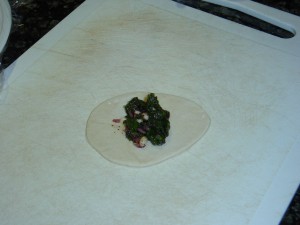
The spinach filling
To create the triangular pyramid shape, lift 2 sides of the circle, each being one third of the circumference and pinch them together half way down to make a raised seam (keeping the filling intact).
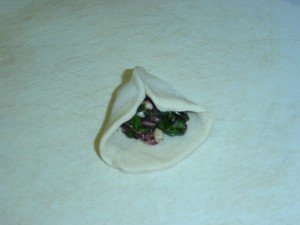
Joining the first two sides
Next, bring the other end to join the two sides creating a triangular pyramid.
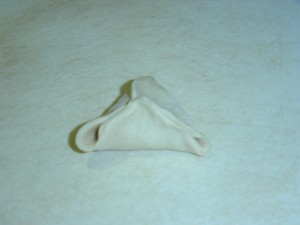
The final fold before sealing
3. Put the filled pastry onto a baking sheet lined with baking parchment and continue until you finish them all. Brush them with oil.
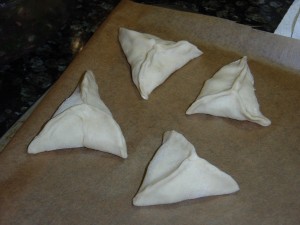
Ready for the oven
4. Bake in a pre-heated fan oven at 200°C/ 400°F for 12-15minutes until golden.
5. Serve hot, warm or even cold with wedges of lemon. Whichever way, they are delicious!

